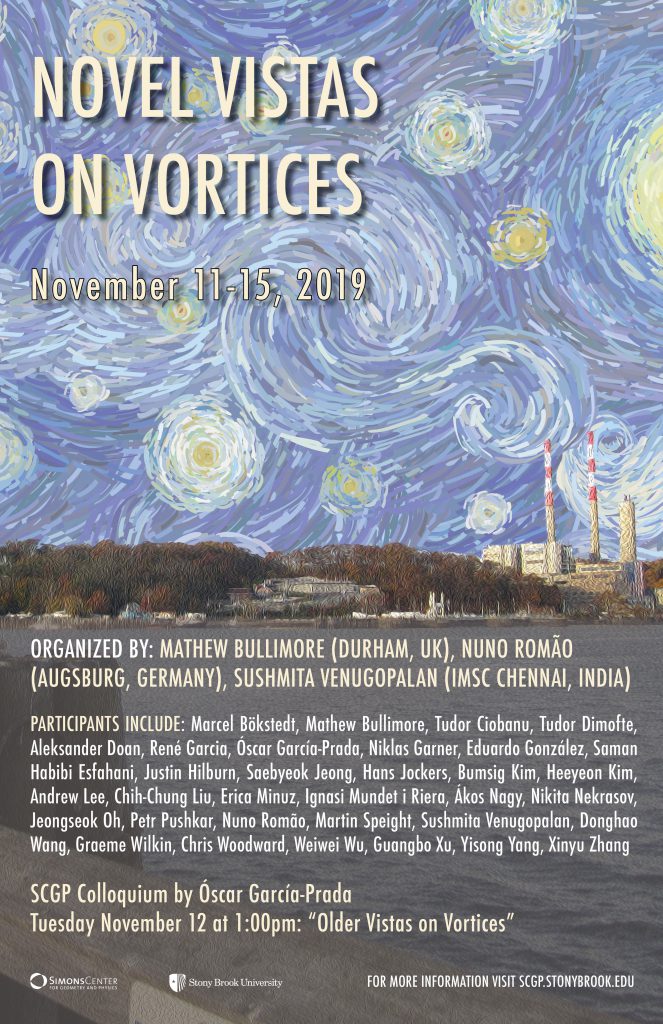Attendee ListShuttle scheduleAbstractsScheduleView Videos
Organized by: Mathew Bullimore (Durham, UK), Nuno M. Romão (Augsburg, Germany), Sushmita Venugopalan (IMSc Chennai, India)
Moduli spaces of symplectic vortices, well known to particle and condensed-matter physicists since the 1970s, have experienced a substantial revival over the last twenty years. This has been motivated, on one hand, by the extension of the vortex equations from linear to nonlinear targets, in a framework that replicates Gromov-Witten theory to the context of Hamiltonian spaces — where vortices become an equivariant analogue of pseudoholomorphic curves enhanced by gauge theory. On the other hand, the geometry and topology of these moduli spaces have been investigated from new viewpoints (e.g. geometric quantization, localization of supersymmetric gauge theories, geometric group theory, algebraic stacks, discrete mathematics), shedding new light both on their physical underpinnings and on sometimes unexpected links to well-established areas of mathematical research.
This workshop will be focused on various strategies to describe these moduli spaces, including their intrinsic geometry and topology, as well as on their relations to various areas of physics (e.g. gauged sigma-models with or without supersymmetry, field theory dynamics, statistical mechanics, quantization, dualities in QFT) and mathematics — with recent developments connecting to topics such as elliptic boundary value problems on surfaces, Gromov-Witten theory and moduli of curves, the theory of surface braids, topology of moduli spaces of Higgs bundles, or Floer homology.
The contributed talks will cluster around three main themes:
(1) Relationship of symplectic vortices to other settings in gauge theory;
(2) Topology and L^2 geometry of vortex moduli spaces;
(3) Vortices and equivariant Gromov-Witten theory.
Talk Schedule
| Time | Title | Speaker | Location |
| 9:45am | Opening/Welcome | N/A | SCGP 102 |
| 10:00am | Quantum wavefunctions and vortex counting | Nikita Nekrasov | SCGP 102 |
| 11:00am | Coffee break | N/A | SCGP 102 |
| 11:30am | Vortices on noncompact surfaces and black holes | Ákos Nagy | SCGP 102 |
| 12:30pm | Lunch | N/A | SCGP Cafe |
| 2:00pm | The L2 geometry of moduli spaces of P1 vortices | Martin Speight | SCGP 102 |
| 3:00pm | Tea time | N/A | SCGP 102 |
| 3:45pm | Gromov compactification of vortex moduli spaces and applications to L2 geometry | Chih-Chung Liu | SCGP 102 |
| Time | Title | Speaker | Location |
| 9:30am | 3d mirror symmetry and vortex invariants | Justin Hilburn | SCGP 102 |
| 10:30am | Coffee break | N/A | SCGP 102 |
| 11:00am | Cohomology of generalized configuration spaces and graph complexes | Erica Minuz | SCGP 102 |
| 12:00pm | Lunch | N/A | SCGP Cafe |
| 1:00pm | SCGP Weekly Talk: Older Vistas on Vortices | Oscar García-Prada | 102 |
| 2:15pm | Finite-energy SW monopoles on Cx∑ | Donghao Wang | SCGP 102 |
| 3:15pm | Tea time | N/A | SCGP 102 |
| 4:00pm | The ADHM vortex equations on Riemann surfaces | Aleksander Doan | SCGP 102 |
| 6:00pm-8:30pm | Banquet | N/A | SCGP Cafe |
| Time | Title | Speaker | Location |
| 10:00am | Twisted indices of 3d supersymmetric gauge theories and moduli spaces of vortices | Heeyeon Kim | SCGP 102 |
| 11:00am | Coffee Break | N/A | SCGP 102 |
| 11:30am | Vortices, variations of Hodge structure, and Arakelov-Milnor inequalities | Oscar García-Prada | SCGP 102 |
| 12:30pm | Lunch | N/A | SCGP Cafe |
| 2:00pm | Vortices and the Morse theory of the Yang-Mills-Higgs functional | Graeme Wilkin | SCGP 102 |
| 3:00pm | Tea Time | N/A | SCGP 102 |
| 3:45pm | Mapping tori and stable pairs | Andrew Lee | SCGP 102 |
| 5:00pm | Palindrome Quartet | Reception & Concert | SCGP Lobby |
| Time | Title | Speaker | Location |
| 10:00am | Aspects of 3d N=2 gauge theories and of quantum K-theory | Hans Jockers | SCGP 102 |
| 11:00am | Coffee Break | N/A | SCGP 102 |
| 11:30am | Vortices and quantum K-theory | Chris Woodward | SCGP 102 |
| 12:30pm | Lunch | N/A | SCGP Cafe |
| 2:00pm | Quantum K-theory for Nakajima quiver varieties and quantum integrable systems | Petr Pushkar | SCGP 102 |
| 3:00pm | Tea Time | N/A | SCGP 102 |
| 3:45pm | Localization by 2-periodic complexes and virtual structure sheaves | Jeongseok Oh | SCGP 102 |
| Time | Title | Speaker | Location |
| 10:00am | Vortices and categories of line operators | Tudor Dimofte | SCGP 102 |
| 11:00am | Coffee Break | N/A | SCGP 102 |
| 11:30am | Adiabatic limit of the gauged Witten equation | Guangbo Xu | SCGP 102 |
| 12:30pm | Lunch | N/A | SCGP Cafe |
| 2:00pm | Stable higher rank flag sheaves on surfaces | Artan Sheshmani | SCGP 102 |
| 3:00pm | Tea Time | N/A | SCGP 102 |
| 3:45pm | CANCELLED (Stratifications for gauged maps) | Eduardo González | SCGP 102 |


